
Before they end up on your plate next to melted butter, lobster start small, very small. Lobster eggs have the odds stacked against them, only 1 or 2 in 10,000 will survive and become an adult. But for those who do, this is their life cycle that takes them from that little tiny egg to being on your plate and all of the people involved in the process. In most destinations you’ll experience a food by simply eating it in a restaurant; however, in the Canadian Maritimes, you can get the complete lobster lifecycle experience.
From the boat, to it’s life in the market, and then finally on your table. I spent a couple weeks traveling with my parents in New Brunswick and Prince Edward Island learning about the lobster industry that is a lifeline for many locals. In doing this research, I was forced to eat a lot of Canadian lobster. It’s a tough job, but someone had to do it.
Under the Sea
Way down on the bottom of the Bay of Fundy or Atlantic Ocean the lobster life-cycle is tough and long. If they survive youth and don’t get eaten by predators then they go through a process of survival that is quite a roller coaster. We know them as having hard shells when they end up on our plates, but in order to grow they have to moult that shell leaving them completely exposed – at which time they hide under rocks and hope for the best. They outgrow and shed their shells up to 25 times during the first 5 years of their life.
In addition to that cool fact, I learned they also have magic powers – they can drop and regenerate claws, arms, eyes, and legs like a superhero! However, if the body and tail get separated they’ll die. Water temperature is key as it determines their molting and hibernation states, which is why you see live lobsters kept in circulating cool water bins as it keeps them in a mild state of hibernation while we get around to buying and eating them.

Fishing huts line the docks of villages all over Maritime Canada.
The Catch
It all starts with the trap – a container that a lobster backs into and never can get out of thanks to the design. I went on a lobster fishing charter out of Charlottetown PEI with Mark at Top Notch Charters to learn all about how the hearty crustaceans are caught. He runs a tourist charter that teaches you how to fish for Canadian lobster, you even get to set buoys, pull the trap out of the water yourself, and band a claw.
In addition to doing a whole bunch of hands on stuff on the charter, I was also able to learn all about the fishing industry. Captain Mark is part of a fisherman dynasty. He’s a 4th generation fisherman. His family has 6 lobster licenses and they work together as a team via 2 way radio during the appropriate fishing seasons. That’s a big deal considering a commercial fishing license costs $350,000. Maybe that’s why people live on their boat.
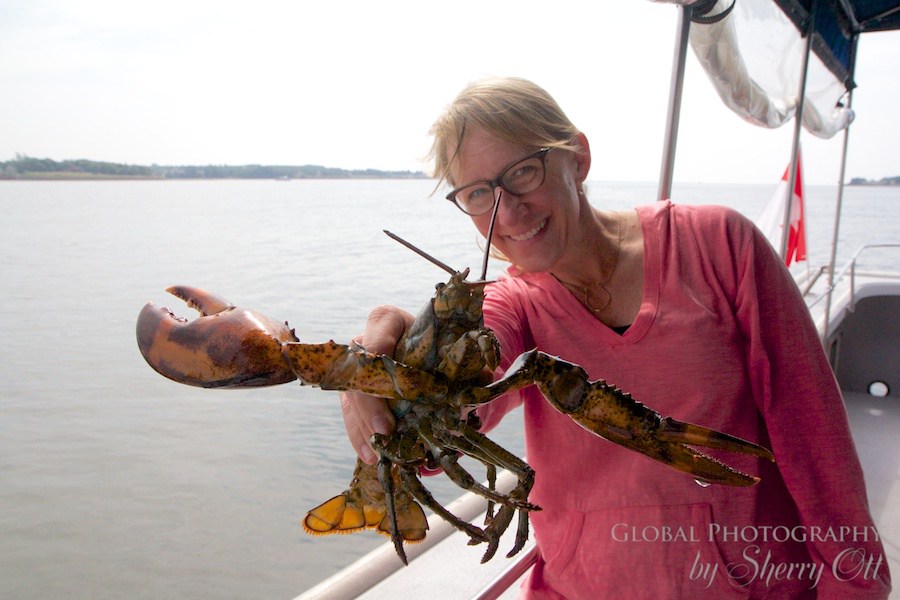
Catching lobsters on Captain Mark’s Lobster charter boat.
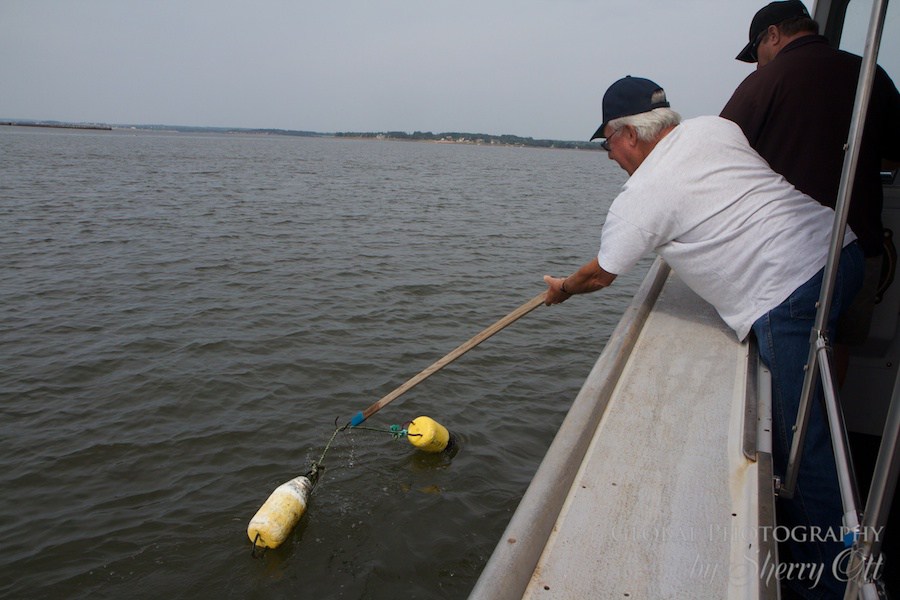
My dad pulling up traps with Captain Mark
Lobster Fishermen make 70% of their income in 2 months time. It means they have to not only be great at catching lobster, but they also have to be great at managing their money. Most of them have to figure out another career for the other 10 months and that’s how Mark and his brother Cody started the Top Notch Lobster and Tuna Fishing Charters. Mark continued to entertain me with lots of fishing tidbits such as:
• There’s an unwritten rules among the fishermen – you don’t fish on Sunday.
• Don’t put your traps where they don’t belong – they will be policed by other fishermen. Everyone has their ‘territory’ that is known – don’t mess with it. After hearing this – I wondered if there was a fishing mafia.
• The colors of the buoys go with the boat and is ‘approved’ by the village which sort of serves as the jurisdiction. Mark’s are black, white, and yellow for the Boston Bruins.
• Lobster makes up 70% of the fishing in the Maritimes.
• Lobster was considered a poor man’s food. It was traditionally fed to prisoners. Mark’s dad used to have lobster sandwiches as a kid in school and he’d pick the lobster out and throw it away else the other kids would think his family was poor.
• Bands are put on the lobster claws to protect them, not the humans. If left unbanded, they will fight to the death – the ultimate cage match.
• 80% of the lobster he catches go to the US.
The afternoon was spent with my dad and I pulling up cages and learning how to determine gender, size, and if there are eggs – all of these things determine if you need to throw the lobster back or if you get to keep it and sell it.
The Middle Man
I went to Alma New Brunswick to learn all about the stuff in the middle and meet Mike from Collin’s Lobster. However it ended up that Mike was as elusive to catch in person as a lobster, so instead I began my talk with Kelsey, the pretty 21 year old blond who smiles at me and says, “I’m sick of picking up lobsters,” as she continues to move the lobsters around in the tank while talking with me.
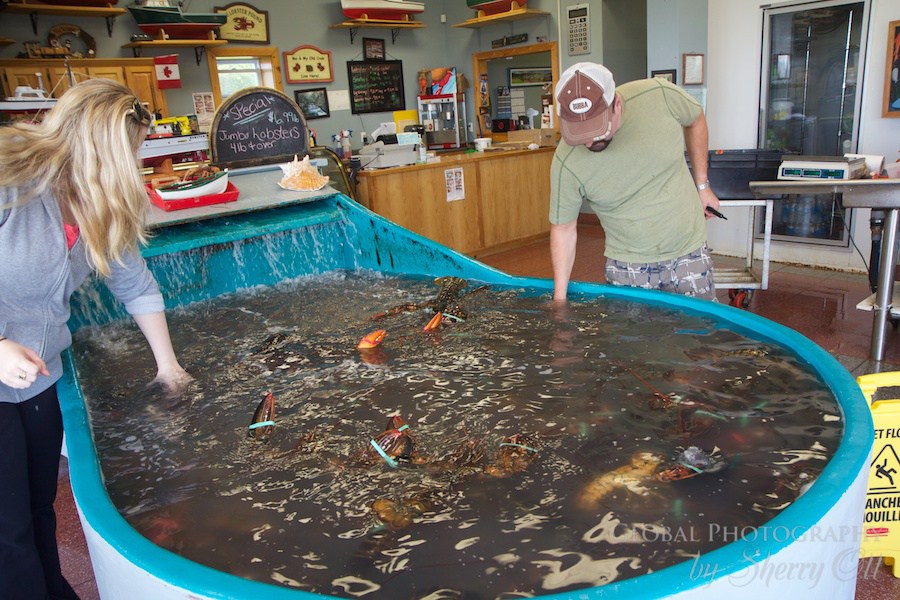
Like Captain Mark, Mike’s family was also in fishing industry for generations. His father was a fishermen and Mike got started selling lobster door to door in the community when he was a kid. He was go-getter even at a young age – or who knows – maybe his father made him do it like my father made me mow the lawn.
Mike now buys from the local fisherman (50 or 60 in the area in a town of 236 people) as they bring in their catches to the docks. Fishing lobster is a tough job in Alma – it’s all based on tide schedules around the Bay of Fundy. You can’t just take the boat out whenever you want as twice a day the boat is sitting on the muddy bottom thanks to the massive tide changes.
As a wholesaler he sells 20% direct to the public and 80% wholesale which mainly consists of a contract for cooked lobster with Sobey’s, the big grocery store chain in the region. And of course he also sells to restaurants. Despite the fishing season restrictions, Mike provide lobsters year around by storing the ones under 4lbs in tubes putting them into hibernation. He moves a max of 30,000 lbs of lobster a day through the shop during the busiest season.
When I asked what makes the Bay of Fundy lobster the best, I was told that it had to do with the colder water which gives it more flavor and the rocky bottom (they don’t walk on the muddy bottom of the Atlantic). I asked what real effect that had and the only answer I got was that they didn’t taste like mud. I’m not sure that sounds too accurate – but what the heck, people come from great distances to get Bay of Fundy lobster so it must just be good.
“Who’s the best fisherman in town?” I asked Mike. ”I can’t say or may get in trouble. Everyone’s good,” responded Mike thoughtfully; a smart answer by a guy who relies on the local fisherman for a living.
On My Plate
What about the financial life of the lobster lifecycle? It’s like any business…by the time it gets to your plate, there’s a lot of expense added that you, the consumer, will pay for. Fishermen get approximately $3.75/lb for market lobsters, and the wholesalers turn around and sells it for around 8.99 per pound around town. Then it ends up as $15 and up when it lands on your plate – or $35 in a fancy restaurant.

The claw – I always save it for the last bite. What’s your favorite part of the lobster?
We decided to skip the fancy restaurant part and instead by directly from the wholesaler, Collin’s Lobster. With Kelsey’s help we picked out 3 big lobsters and went down to the adorable little Parkland Village Inn in Alma run by Andy and his wife. Yet another family business, Parkland Inn ended up being my favorite place we stayed in all of New Brunswick due to the great hospitality from Andy and the setting in this adorable small town.
In addition to being a great place to stay, the Parkland Inn had a beautiful backyard near the fishing docks looking out at the Bay of Fundy. We sat out on the picnic tables and ate our fresh lobster from Collin’s Lobster as Andy brought us out cold beer. It was a perfect sunny day as we dawned our lobster bibs and prepared for a simple feast and watched the tide start to roll in. Subsequently the fishing boats started returning to the docks since they could make it back with the high tide.
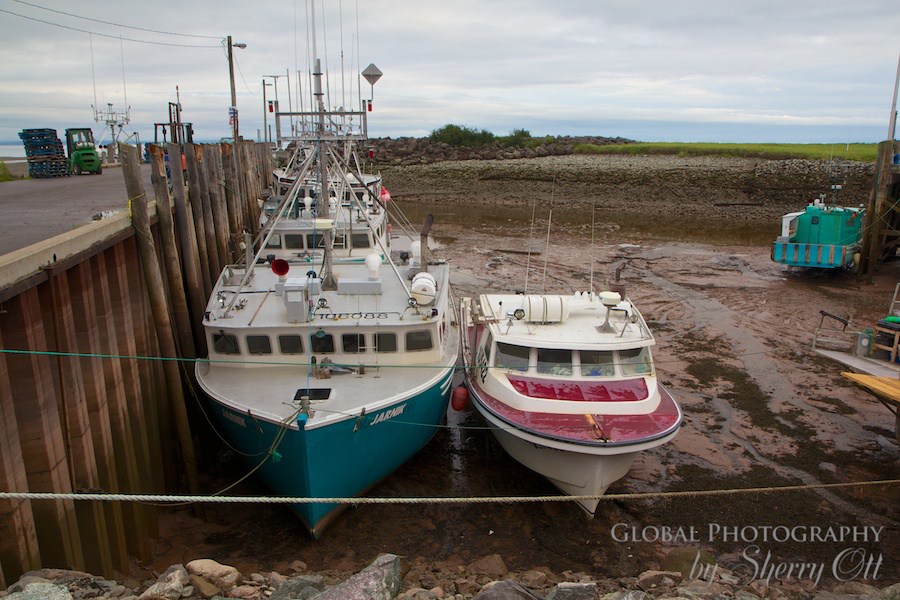
Low Tide at the Alma Docks. These fishing boats have to wait a while to go out.
There is no better feeling than sitting outside with a lobster bib on, cracking claws, eating with your hands, and drinking beer with people you love. I savored every last bite always leaving the big claw for the end. As we dumped all of our shells into the garbage and finished up our last sips of beer, I though about how we were the end of this long complex lobster lifecycle – and I was completely happy with that. My belly full of lobster is always a reason to be happy.
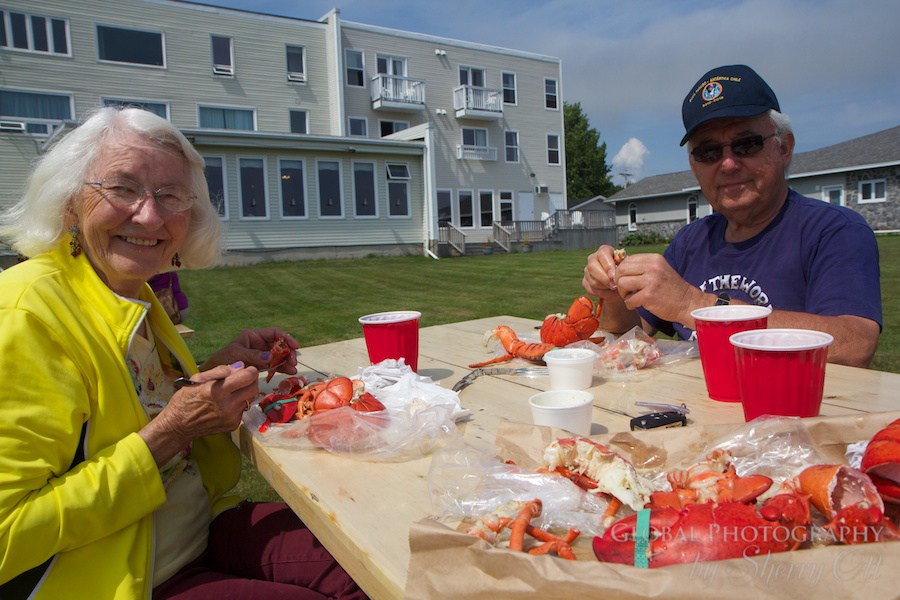
Our Lobster Picnic at Parkland Inn.
How to Recreate the Lobster Lifecycle Experience Yourself in the Maritimes:
Prince Edward Island:
Top Notch Charters Website
Lodging in Charlottetown – Elmwood Heritage Inn
Buy Fresh Lobster – MacKinnons Lobster Pound Charlottetown
Great places to Eat Lobster – Lobster Shack in Souris Beach
Dave’s Lobster – known for their lobster tacos
New Brunswick:
Buy fresh lobster at Collin’s Lobster Website
Lodging in Alma – Park Village Inn
Great Places to Eat Lobster – Park Village Inn Restaurant – let them prepare it for you!
Nova Scotia:
Buy & Eat Fresh Lobster – Halls Habour Lobster in the Rough
Great Places to Stay and eat lobster – Guysborough at the Des Barres Manor Inn & Restaurant
The post Ocean to Table Lobster in the Canadian Maritimes appeared first on Ottsworld Unique Travel Experiences.

Sherry Ott is a refugee from corporate IT who is now a long term traveler, blogger, and photographer. She’s a co-founder of Briefcasetobackpack.com, a website offering career break travel inspiration and advice.
Additionally, she runs an around the world travel blog writing about her travel and expat adventures at Ottsworld.com.com.








